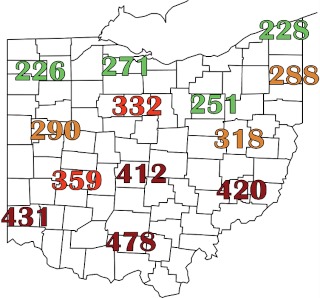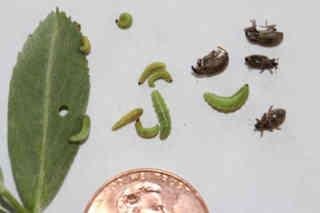By Aaron Wilson and Kelley Tilmon et.al

Accumulated growing degree days (base 48°F sine calculation method) for January 1-April 24, 2023 at several CFAES Ag Weather System (https://www.oardc.ohio-state.edu/weather1/) locations and additional NOAA stations around Ohio (Midwestern Regional Climate Center (https://mrcc.purdue.edu).
Despite this week’s cold weather, enough locations have accumulated enough degree days that some farmers are experiencing noticeable damage from alfalfa weevil. In this degree-day map, anything other than green is a location deserving closer attention.
Alfalfa fields should be scouted weekly for weevils until at least the first harvest. Follow-up scouting may be needed after the first harvest in heavily infested fields.
Spot problem fields early by checking alfalfa tips for feeding damage – small holes and a tattered appearance. Fields that have a south facing slope tend to warm up sooner and need to be checked for weevil earlier.

Green alfalfa weevil larvae (the main feeding stage) at various growth stages, and brown adults. Photo by Julie Peterson, University of Nebraska.
Here is a video about scouting weevils in alfalfa: https://forages.osu.edu/video
Scout for alfalfa weevils by collecting a series of 10 stem samples from various locations. Place the stems tip down in a bucket. After you’ve collected 10 stems, shake the stems vigorously into the bucket and count the larvae. Divide this number by 10 to get the average number of larvae per stem. Do this procedure at least 3 times (for a grand total of 30 stems, in 10-stem units). Alfalfa weevil larvae go through four growth stages (called instars). The shaking will dislodge the late 3rd and 4th instar larvae which cause most of the foliar injury. Close inspection of the stem tips may be needed to detect the early 1st and 2nd instar larvae. Also record the overall height of the alfalfa. The treatment threshold is based on the number of larvae per stem, the size of the larvae and the height of the alfalfa according to the following table. When alfalfa is around 12-16 inches in height, growers can consider an early harvest rather than spraying, if they feel the current growth is sufficient to justify the cost of harvest or if spraying can’t be done for some reason (e.g., organic production). When alfalfa stem height is over 16 inches, we would always recommend an early cutting. In those fields which are cut early for alfalfa weevil, the regrowth should be checked closely to make sure weevils that are still alive do not prevent good regrowth.

For more information about alfalfa weevil, visit our factsheet at https://ohioline.osu.edu/factsheet/ENT-32 If you are interested in a more detailed treatment of how growing degree days can be used in management decisions for alfalfa weevil, visit this website from the University of Kentucky https://entomology.ca.uky.edu/ef127
Crop Observation and Recommendation Network
C.O.R.N. Newsletter is a summary of crop observations, related information, and appropriate recommendations for Ohio crop producers and industry. C.O.R.N. Newsletter is produced by the Ohio State University Extension Agronomy Team, state specialists at The Ohio State University and the Ohio Agricultural Research and Development Center (OARDC). C.O.R.N. Newsletter questions are directed to Extension and OARDC state specialists and associates at Ohio State.
Source : osu.edu